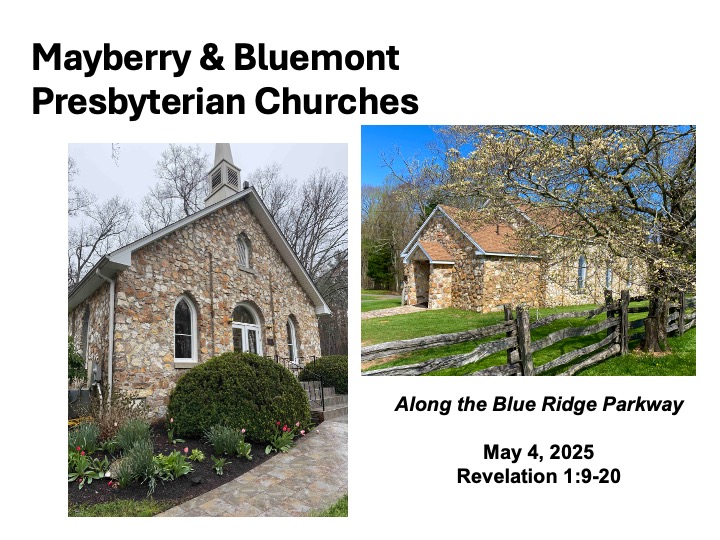Jeff Garrison
Mayberry and Bluemont Churches
May 4, 2025
Revelation 1:9-20
At the beginning of worship:
We began our tour of the opening chapters of Revelation last Sunday. I devoted a bit of time in that sermon discussing the term used in verse 4, “Grace and Peace.”
I discovered something else about this term from a book I’d read almost 40 years ago. I’d forgotten this. The book I pulled off my shelf and reviewed is titled Comfort and Protest: The Apocalypse from a South African Perspective. Allan Boesak wrote it at the height of apartheid in his country. He drew on ancient Roman historians, to point out that this familiar greeting for Christians was also used by the Caesars.
But the message from Caesar, while proclaiming grace and peace, might lack it. Domitian, the emperor under whose reign some think Revelation was written, would always include these words in introductions to his proclamations, including those calling for a death sentence against his foes.[1]
For the faithful in the first century, they had to ask themselves under whose grace they wanted to live. Would it be the “grace of Caesar, whose ‘mercy’ might spell death, destruction, and inhumanity’”? Or would it be the grace of God who frees us from fear and sin and saves us from death? Under whose grace do we live?
Before reading the Scripture
Today, we’ll look at John’s first vision in Revelation, where he sees Christ. This is the beginning of the letter to the seven churches. What we looked at last week was the salutation, the opening which was a common form for letters in the first century.
The body of John’s letter begins with a vision. This isn’t something uncommon. A vision kicked off the prophetic ministries of Isaiah and Ezekiel.[2] It also kicks off John’s ministry. It’s awesome, yet it draws on a similar vision of the prophet Daniel. Overwhelmed, John falls as if he’s dead. But Christ lifts him up and by the time this opening vision ends, John is ready to begin writing what he has seen. Let’s listen to what John sees and hears his first vision:
Read Revelation 1:9-20
“I’m one of you,” John begins. He assures those who listen to his letter that he is their brother. John shares with them in persecution, in the hope for the coming kingdom, and in their endurance.
Furthermore, John preaches the gospel. And this preaching got him into trouble. He has been exiled to Patmos, a small rocky island some 75 miles east of Ephesus. There is no evidence the island was an Alcatraz, a prison for hardcore convicts.[3] Instead, it seems to have been a place where the Romans sent troublemakers, knowing they’d be out of sight and not too much territory to get into mischief.
For John, this meant he lost his congregation and the ability to reach other communities with his preaching. But now, through this vision, God speaks through John by letter.
John tells us this vision happened on the Lord’s Day, a day when he would normally be gathering with other believers for worship. But in exile, he not able to do this. So, Christ comes to him, beginning with a loud voice with the blast like a trumpet saying, “Write this and send it to the seven churches.”
John turns to see where the voice is coming from, and he sees seven golden lampstands. Standing in the middle of these candlesticks is one who resembles the Son of Man, in other words Christ. This is not the Jesus John knew in Galilee. This is the resurrected Christ in all his glory. The candlesticks represent the church that is to bring light into a darken world.[4] And Christ, standing in the middle, reminds us that he’s always with the church, even during times of persecution and danger.[5]
The vision of the Son of Man is like the one Daniel experienced.[6]Clothed with a long robe with a golden sash across his chest, his hair has turned white. While this may sound like Jesus had prematurely aged, the whiteness probably means purity. His eyes appear to have fire in them and his voice sounds like the rapids of a raving river.
Instead of taking this vision literally, each part is symbolic. The sharp two-edged sword from his mouth draws upon John’s gospel and the Book of Hebrews. In John’s gospel, Jesus is the Word become flesh.[7] In Hebrews, we’re reminded God’s word is a sharp two-edged sword.[8] In his hands he holds the seven stars. Again, as with the candlestands, the seven implies perfection. These stars represent the angels watching over the seven churches. Starting next week, we’ll see each church receives an individual message within the larger letter. The churches are not perfect.[9] But they can be made perfect in Christ.
The feet of the Son of Man are bronze in John’s vision.
Again, this leads us back to the Book of Daniel. Nebuchadnezzar had a dream of a similar being, except that its feet were clay. When struck at the feet, the entire statue falls and shatters into pieces. Daniel interpreted this dream for the King of Babylon.[10]
The vision in Daniel reminds us of the limitations of people and human organizations. Sooner or later, not only do we, but also our institutions, come to an end. Here, the feet of Christ are different. Bronze is made by combining iron and copper. Iron is strong but will rust. Copper won’t rust but is soft and pliable. But when forged together into bronze, the metals take the best from each to create an enduring material.[11]
The feet of the comic Christ are not clay. They will stand while human organizations, sooner or later, will fail.
Some suggest the stars in Jesus’ hands presents an anti-astrology message. Instead of looking at the stars for the fate of the world, Jesus’ hands hold its fate. It’s also challenges the Roman Empire. The true cosmic leader is not the emperor but Christ.[12]
While the vision of Christ draws on images of God, John doesn’t make Jesus and God two competing entries. Instead, John reminds us that God is revealed in Jesus Christ.[13]
This vision overwhelms John. He falls as if dead. But Christ reaches out to lift him up and, as we often hear in Scripture when there is a divine or angelic encounter, John is told not to be afraid. Again, as we heard last week, Christ identifies himself as the first and last (or the A and Z).[14]
Here we have a connection between the cosmic Christ and the earthly one, for he announces that he was dead (and remember, John was at the foot of the cross to watch[15]), but he is now alive forever. The cosmic Christ assigns John a task. He’s to write what he has and will see. He’s also given clues to what he has seen, the symbolic meanings of the stars and lampstands.
What might we take from this passage? Can we find comfort in these words? Certainly, we can, if we follow Jesus. We are reminded, even when going into persecution, that he is with us. Jesus Christ, who remains with his church, is in control today and always. Regardless of what happens in this life, and bad things can happen, Jesus resides with us. In the life to come, we’ll reside with him. Thanks be to God. Amen.
[1] Allan A. Boesak, Comfort and Protest: The Apocalypse from a South African Perspective (Philadelphia: Westminster Press, 1987), 47.
[2] Isaiah 6 and Ezekiel 1.
[3] Some have suggested Patmos was a prison, but most scholars disagree and see it mostly as a place of exile. See Robert H. Mounce, The Book of Revelation, Revised (1977, Grand Rapids, MI: Eerdmans, 1997),54 (especially note #5).
[4] Mounce, 57; Bruce M. Metzger, Breaking the Code: Understanding the Book of Revelation (Nashville: Abingdon Press, 1993), 26. .
[5] G. B. Caird, The Revelation of St. John the Divine (New York: Harper & Row, 1966), 25.
[6] Daniel 7:9-10.
[7] John 1:14.
[8] Hebrews 4:12.
[9] See Revelation 2 and 3.
[10] Daniel 2:31-35. See also https://fromarockyhillside.com/2021/08/22/gods-wisdom-vs-human-wisdom/
[11] Eugene H. Peterson, Reversed Thunder: The Revelation of John and the Praying Imagination (San Francisco: Harper & Row, 1988), 35-36.
[12] M. Eugene Boring, Revelation: Interpretation, A Bible Commentary for Teaching and Preaching (Louisville, KY: JKP, 1989), 84. See also Mounce, 57.
[13] Boring, 83. See also John 1:18 and 14:9.
[14] See Revelation 1:4 and 1:8. See also https://fromarockyhillside.com/2025/04/27/the-beginning-of-revelation/
[15] John 19:20. Some question John of Patmos being different than John of the gospel, but I disagree as their topics are too similar.


An encouraging start to my Saturday, Jeff. Thanks!
Good to hear from you, Bob. I hope you’re doing well. I hope we can catch up in late June when I’m up that direction
Thank you.
You’re welcome.
I hope you have a good week.
So far, so good. I hope your week goes well, too.
Amen to your last paragraph. Amen!
Thanks.